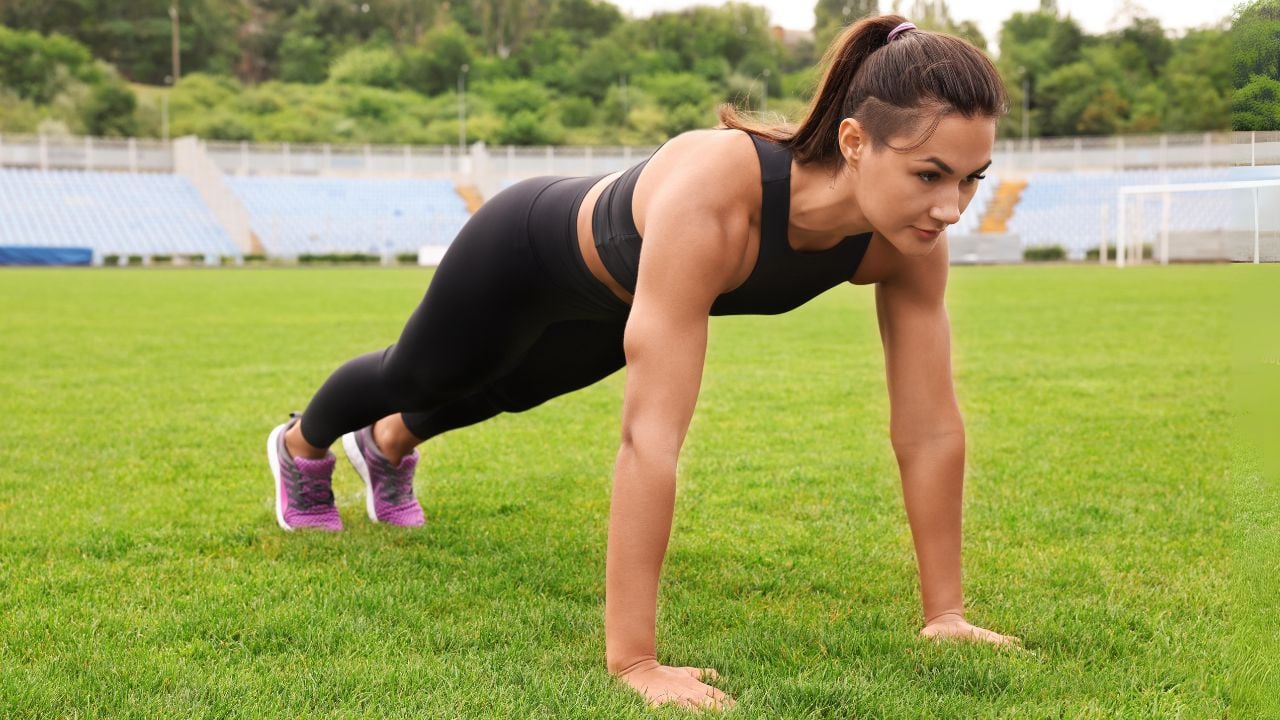The plank-to-pushup, also known as the Plank push-up, is a combination of the two exercises (Plank and Push-up) that provides the benefits of both.
It is a brilliant bodyweight exercise that helps you to develop the strength and stability of your core and upper body.
It is simple to perform; you alternate between a high plank and a forearm plank with control, then push your body back up one arm at a time.
This is more of a strength-building exercise than a cardio exercise, and it can also help you burn more calories.
Use our free calculator to know your weight loss calories requirement.

Plank Push Up Muscles Worked
The Plank Push-up position engages a wide range of major muscle groups, making it an effective component for your workout.
- The primary muscles that work are the pectoralis, back, and core, including the erector spinae, rectus abdominis (abs), and transverse abdominis.
- In addition, the position uses the trapezius (traps), rhomboids, and shoulder muscles, of the upper body, as well as the glutes, quadriceps, and calf of the lower body.

Know More: Side Plank: Benefits, Variations, Muscles used, Tips
How To Do Plank Push Up
- Lie face down on an exercise mat with your hands should be shoulder-width apart.
- Your knees should be about hip-width apart, your head facing forward, and your palms flat on the floor.
- Start by getting into a push-up position, bending your elbows, and resting your weight on your forearms instead of on your hands.
- Keep your core, butt, and quads tight, and avoid arching your back.
- Your body should form a straight line from your shoulders to your ankles.
- Brace your core by contracting your abs like you were about to be punched in the gut.
- Press your body up into the top position of a push-up by extending your arms one at a time.
- Pause, then reverse the movement and return to your elbows. That’s 1 rep.
- Choose your sets and repetitions based on your ability to maintain good form throughout.
- Begin by performing 3–4 sets of 8–12 reps
Tips and Form
- Before you start, move your whole body a little, like jogging or jumping rope, to get ready and help your muscles loosen up so you avoid injury.
- Put your hands a bit wider than your shoulders for a strong base. According to biomechanics (how your body moves), this spreads your weight better.
- Keep your body straight, making a line from your head to your feet without any bending in the middle. This will keep your spine safe and work the right muscles.
- Breathe normally and don’t hold your breath. Just keep it steady to stay firm longer.
- Use a mat or something soft under your hands to help you feel better and not slip. Comfort helps you focus.
- Keep your legs straight and squeeze your stomach and bottom for balance, using your core power, not just your arms.
- Slow moves build strength the right way, so go slow and move carefully. Don’t drop down or push up too fast.
- If push-ups feel too hard, put your knees on the floor to practice since everyone starts somewhere.
- When you’re ready, make it more challenging by putting your feet on a bench to work your muscles even more.
Benefits of Plank Push-ups
There are several important benefits to practising alternating plank push-ups. They are one of the best exercises for strengthening your core and upper body, and when you move, your leg muscles also work.
- When you do push-ups and planks, you work your core muscles and gain all the benefits of a strong core. In addition, plank push-ups work the whole body.
- Planks are push-ups that simultaneously condition the front and back of the body. When muscles are equally developed on both sides of the body, better posture is achieved, spinal support is increased, and lower back pain is decreased.
- Planks are important for functional movement, which is important for living a healthy life.
- Like push-ups, the plank variation combines strength and cardiovascular exercise. It can help you burn calories and regulate weight.
- Plank push-ups require no equipment and can be done anywhere. This makes them an excellent exercise for people who have little time or who can’t go to the gym often.
To Stay Motivated: 150+ Gym Workout Motivational Quotes To Stay Fit

Manish is a NASM-certified fitness and nutrition coach with over 10 years of experience in weight lifting and fat loss fitness coaching. He specializes in gym-based training and has a lot of knowledge about exercise, lifting technique, biomechanics, and more.
Through “Fit Life Regime,” he generously shares the insights he’s gained over a decade in the field. His goal is to equip others with the knowledge to start their own fitness journey.
